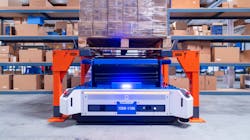Fetch Robotics Announces Full Conformance with R15.08, the First Safety Standard for Industrial Mobile Robots
Fetch Robotics announced that its full suite of autonomous mobile robots (AMRs) conforms with ANSI / RIA R15.08, the new safety standard for industrial mobile robots. This latest milestone ensures that Fetch’s AMRs can be safely used in all current use cases throughout warehouses, factories, distribution centers and fulfillment centers.
Released on Dec 25th, 2020 by the RIA (Robotics Industry Association), R15.08 is the new safety standard for industrial mobile robots. In recent years, a growing number of manufacturing, distribution, and fulfillment centers have begun using mobile robots for a variety of material handling tasks, from moving packages between workstations to transporting pallets across a warehouse. Prior to R15.08, however, there was no safety standard specifically designed for AMRs, which move autonomously through facilities and often need to avoid obstacles like heavy machinery and human workers. R15.08 provides technical requirements for the design and integration of AMRs, ensuring that AMRs protect facility operators and workers from injuries that can result in civil and criminal liabilities, regulatory fines, and higher insurance costs.
Read more about the R15.08 safety standard
“The publication of R15.08 is a watershed moment for the AMR industry,” said Melonee Wise, CEO at Fetch Robotics. “Whereas previous safety standards were designed for industrial arms or automated guided vehicles, R15.08 is specifically designed to address safety concerns unique to fully autonomous robots. This new standard will set the foundation for safer workplace environments overall.”
The new standard provides a comprehensive framework to assess the safety of AMR systems, which are defined as both the AMR base and any additional accessories.
- R15.08 specifies that if the original manufacturer or a third party adds an attachment to an AMR (creating an AMR system), it is considered a system manufacturer and therefore is responsible for the certification and safety of that device. As a result, the standard covers a wide number of manufacturing arrangements, such as when an AMR manufacturer sells the robotic base to an integrator who then adds an attachment (like a rack, cart, bin or arm) so the robot can complete workflows.
- The standard also covers integrators that add attachments and stations to move items like pallets on or off of an AMR base. Specifying the coverage of R15.08 for both the AMR itself and the complete AMR system mitigates risk for end-users, who prior to R15.08 may have been using an AMR that conformed to R15.08 with an attachment that did not conform to R15.08.
As the manufacturer of both its AMRs bases and its AMR accessories, Fetch Robotics can ensure that its AMR systems conform to the new safety standards, giving customers peace of mind when deploying the technology.
“Safety is our top priority in selecting and deploying automation solutions in our manufacturing and warehousing facilities,” said Harry Chase, Director of Advanced Materials at GE Appliances, a Haier company. “Fetch Robotics is our main provider of autonomous mobile robots. The fact that their AMRs conform to R15.08 gives us confidence they improve employee safety as well as help us achieve our efficiency goals.”
This announcement comes on the heels of Fetch’s release of its newest AMR, the PalletTransport1500, which supports cross-docking, returns, and case picking workflows for contactless pallet transport in distribution centers.
